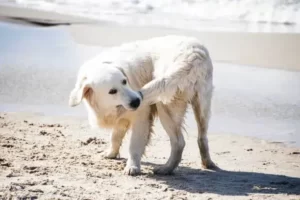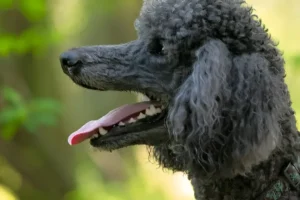A dog’s tail is a fantastic communication tool. It can express excitement, alertness, submission, and even pain. So, when your dog’s usually perky tail suddenly hangs low, it’s natural to be concerned. The reasons for a drooping tail can range from a simple case of overexertion to more serious health issues. Let’s explore the possible causes and what you can do.
Medical Causes of a Drooping Tail
Muscle Strain or Overexertion: Similar to how humans get sore muscles, dogs can overwork their tails during play or swimming. This often causes temporary tail droop, resolving with rest.
Tail Injury: Direct trauma to the tail – a bite, a fall, or getting it caught in something – can cause pain, swelling, or an unusual angle, resulting in the tail hanging low.
Anal Gland Issues: Located on either side of the anus, anal glands can become infected or impacted, causing significant discomfort near the base of the tail. Signs include scooting, excessive licking of the area, and a lowered tail.
Spinal Problems: Conditions affecting a dog’s spine, like arthritis or disc problems, can interfere with the nerves controlling tail movement. You might notice weakness, difficulty moving the tail, or a constantly low position.
Environmental and Physical Reasons
Overexertion: Even without water involved, too much exercise can lead to muscle soreness and a temporarily down tail. This is especially common in breeds not used to a lot of activity.
Cold Exposure: Some dogs, particularly short-haired breeds, are sensitive to cold temperatures. Their tail muscles might stiffen up, causing a temporary droop.
Confinement: If your dog has been confined to a crate or small space for an extended period, they might hold their tail low due to discomfort or restricted movement.
Emotional Reasons for a Low Tail
Fear and Anxiety: A tucked or lowered tail is a classic sign of fear in dogs. Look for other body language cues like trembling, cowering, or hiding.
Submission: Dogs may hold their tail low to signal appeasement or submission, especially around other dogs or unfamiliar people.
Feeling Unwell: A general sense of illness or discomfort, even without a specific injury, can cause a dog’s tail to droop.
Tail Communication Chart
Understanding a dog’s tail language is key to figuring out what they’re trying to tell us. Here’s a quick guide:
| Tail Position | Possible Emotional States | Other Body Language Clues |
|---|---|---|
| High Tail | Alert, Excited, Playful, Confident | Ears perked up, energetic posture, wagging vigorously |
| Low Tail | Submissive, Fearful, Unwell | Cowering, ears tucked back, licking lips, tense body |
| Tucked Tail | Intense Fear, Submission, Extreme Appeasement | Tail between legs, hunched posture, may be trembling |
| Neutral Tail | Relaxed, Curious, Focused | Ears up, loose body posture, sniffing, exploring |
| Stiff, High Tail | Dominant, Alert, Potentially Aggressive | Staring, tense posture, low growling |
| Slow Wag | Unsure, Cautious, Investigating | Tentative, ears slightly back, hesitant movements |
| Fast, Small Wag | Excited, May Indicate Arousal or Nervousness | Ears alert, body vibrating, may be whining or barking |
Breed-Specific Considerations
Tail Types: Dogs have amazing tail diversity! Some breeds, like Greyhounds and Whippets, are known for their naturally low-hanging tails. Others, like Pugs and Shiba Inus, have unique, tightly curled tails. If your dog’s tail is usually low or curled, a further droop might have different causes than in a breed known for a high, wagging tail.
Breed-Specific Health Risks: Sadly, certain breeds are predisposed to health conditions that can affect tail movement. For example, German Shepherds have a higher risk of developing spinal issues that could cause tail weakness or drooping. Knowing your dog’s breed background can help your veterinarian in diagnosis.
What Should I Do?

Observe Carefully: Note when the tail drooping started, any accompanying symptoms, and recent changes in your dog’s routine.
See a Veterinarian: If your dog seems in pain, the tail droop lasts more than a couple of days, or you notice other concerning symptoms, seek veterinary advice.
Provide Rest and Comfort: For minor cases, offer rest and a warm environment. Gentle massage near the base of the tail can sometimes help.
Address Emotional Concerns: If fear or anxiety seem to be the issue, work on positive reinforcement, provide safe spaces, and consider consulting a dog behaviorist.
Did You Know? Fun Facts About Dog Tails
Balance and Agility: A dog’s tail acts as a counterbalance, aiding in movement, balance, and sharp turns.
Scent Communication: The base of a dog’s tail contains unique scent glands used for communication with other dogs.
Tail Diversity: Even within breeds, tails come in various lengths, shapes, and thicknesses!
Conclusion
A down tail warrants attention, but don’t panic! By careful observation, understanding potential causes, and (when needed) consulting with your vet, you can get to the bottom of the issue and help your furry friend feel their best again.
The photo featured below the post headline is Credit: cmannphoto/istockphoto
I hope you find this post helpful and informative. If Yes’ feel free to share it with your friends!
Frequently Asked Question
How long does limber tail last?
Most cases resolve within a few days to a week. If it persists longer, see your veterinarian.
Could a down tail be a sign of a serious problem?
While often minor, it can sometimes signal an underlying medical issue. Don’t hesitate to consult your vet if concerned, especially if other symptoms are present.
My dog’s tail is down and they’re shaking – what does that mean?
Shaking, along with a lowered tail, could indicate fear, anxiety, or pain. Pay attention to your dog’s environment and behavior for potential triggers.
What does it mean when a dog’s tail is down but still wagging?
A low but wagging tail might indicate uncertainty, caution, or a submissive greeting. Observe your dog’s overall body language for clues.
My dog’s tail is suddenly limp, what should I do?
A completely limp tail could signal limber tail or a serious injury. If your dog is in pain or the limpness persists, seek immediate veterinary advice.
Can a dog break its tail by wagging too hard?
While uncommon, overly enthusiastic wagging can sometimes lead to tail injuries.
My puppy’s tail is always down, is this normal?
Observe your puppy’s breed and overall energy levels. Some puppies may take time to develop the muscle control to hold their tail high. If it remains consistently low with other signs of lethargy, consult your vet.
What home remedies can I try for a drooping tail?
For suspected minor muscle strains, offer rest and warmth. If no improvement is seen within a day or two, consult your vet.
How can I tell the difference between a fearful tail and an injured tail?
A fearful dog will often have other submissive body language cues (cowering, tucked ears). Look for signs of pain like whimpering or difficulty moving.
My dog hides its tail when scared. Is this normal?
Yes, tucking the tail is a natural protective instinct when a dog feels extremely fearful.
Are certain dog breeds more likely to have tail problems?
Yes, breeds with long tails (retrievers), working breeds, and those prone to spinal issues (German Shepherds) may have a higher risk.









